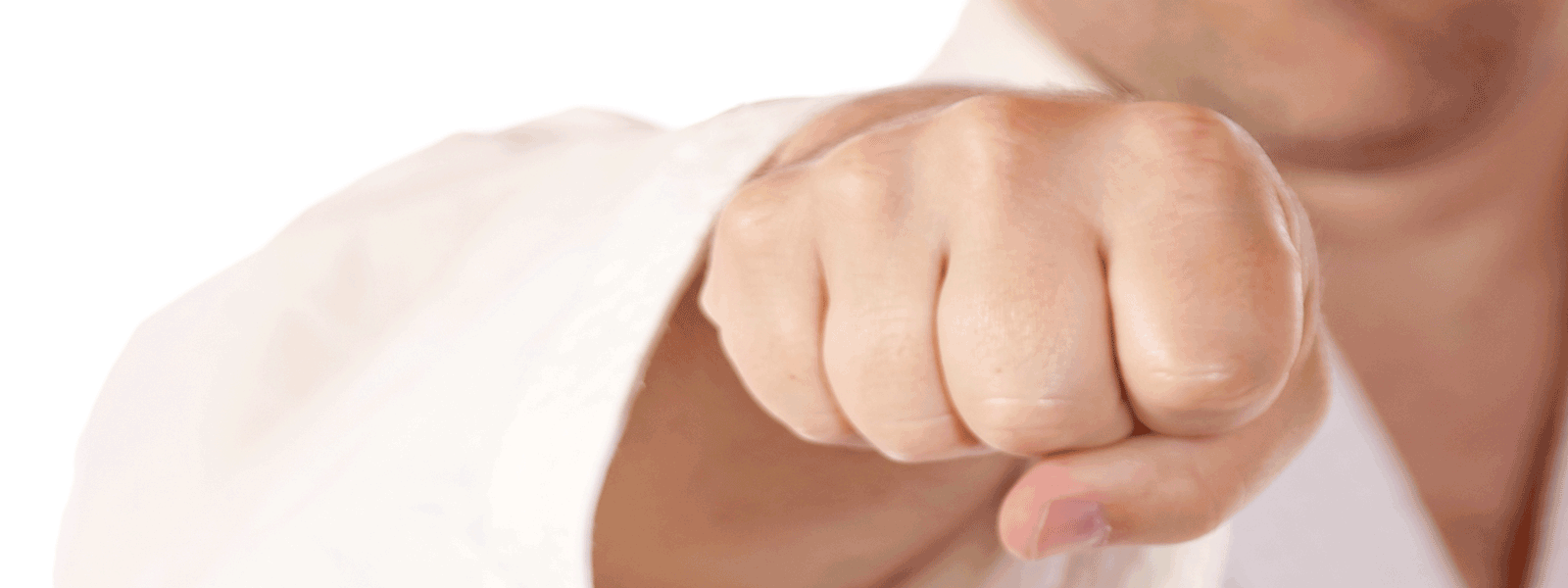Bounty Hunter Reaches Out For Love Of Animals from Jennifer Greshowak on Vimeo.
Gaining Independence Through Martial Arts
By Becka Kurtz, Executive Secretary
Opportunity Manor Inc.
1908 Kruchten Court South
PO Box 280
Sartell, MN 56377
Martial arts training is said to improve physical functions such as strength, balance and stamina. More importantly, it has been proven to increase self worth, self esteem, confidence, independence and an overall improvement in quality of life.
Through Pathway to Opportunities (PTO) collaboration with the St. Cloud Soo Bahk Do Karate School and Master Bill Nelson, 2 of our consumers are shining examples of this. In August 2008 Dustin Potratz and James Klinkner of PTO were awarded their orange belts in the art of Soo Bahk Do.
The martial art of Soo Bahk Do forges the body towards gaining ultimate use of its faculties through intensive physical and mental training. It promotes a healthy and disciplined mind, strong personal character, and respect for life and nature. It also helps one achieve a mature attitude, as well as gives you the mental strength to find your full potential.
In 2007, PTO was fortunate to have Scott Ridlon teach self defense classes to our participants. After taking the class, Dustin and James showed further interest in martial arts and were given the recommendation to take classes from Bill Nelson, Master (sixth degree black belt) in Soo Bahk Do.
He then adapted his classes to fit the needs of our consumers. They began taking regular classes, continuing to increase their rank to the orange belt that they now hold.
Some of the things they have learned through these classes are basic techniques, strikes, kicks, basic form, round house kicks and knowledge of lower rank requirements. They were also able to break boards and spar.
Not only have they gained knowledge of the physical aspects of the art, they continue to gain self worth, confidence, and work toward independence.
What is Soo Bahk Do Moo Duk Kwan?
First it is important to understand that Soo Bahk Do is the Art and Moo Duk Kwan is the style. Soo Bahk Do is the technical side, and the Moo Duk Kwan is the philosophical side of “Soo Bahk Do Moo Duk Kwan.” The name “Bahk” originated in the age of Chun Chu (2700 years ago)according to the Moo Yei Dobo Tong Ji, which is one of the oldest records of Korea's martial arts. Soo Bahk Do (combat with bare hands and feet) is the only Korean martial art handed down from the Ko Ku Ryo Dynasty, thereby making it the oldest Korean martial art; approximately 2,000 years old.
Translated literally, Moo Duk Kwan means “Institute of Martial Virtue.” Our founder, Kwan Jang Nim (Grandmaster) Hwang Kee established the Moo Duk Kwan on November 9, 1945 to reinforce and preserve this traditional approach and to bind all practitioners in a culturally rich organization offering respect, fellowship and the search for an end to conflict. It is the scientific use of the body in methods of self defense, combined with a strict philosophy guiding the practitioner towards discovering their full potential. Soo Bahk Do, translated means “Hand Striking Way”, and is the means to forge a body towards gaining ultimate use of its faculties through intensive physical and mental training. It is an art of self defense and philosophy that's secrets cannot be bought at any price other than serious and rigorous training. Its history is a long and honorable one.
What makes Soo Bahk Do different form other martial arts?
There are many fine styles of martial arts. Two of the many things that separate our art (Soo Bahk Do) from all other arts and make it unique are its versatility and philosophy. Due to the fact that ancient Korea was constantly attacked by both Japan and China, Soo Bahk Do became versatile out of necessity, the result being an art which demands mastery of the whole body, techniques ranging from quick and spontaneous movements to slow graceful flowing movements gives not only variety but also challenges everyone. Second, many styles teach effective self-defense and fighting principles, but Soo Bahk Do offers much more than just that. Learning fighting techniques without a strong philosophy is to burden society with more dangerous people. We use Soo Bahk Do to realize our full potential and emphasize “virtue in action” demonstrating courage, discipline, confidence and humility through our sincere efforts in training and our behavior towards others. You won’t just hear our philosophy you’ll see it in action. This is what makes Soo Bahk Do so unique.
History of Soo Bahk Do
Soo Bahk Do is the name of the art we study and its direct translation is Soo (hand), Bahk (strike) and Do (art or way).
According to the Moo Yei Do Bo Tong Ji, the name “Bahk” originated in the age of Chun Chu (2700 years ago) and the name “Soo Bahk” originated during the early Jon Han Dynasty in China (2200 years ago). This is the oldest reference to any martial art name in Korea, based on the historical documentation available.
Numerous descriptions of the name “Soo Bahk” were recorded in the historical documentation and wall painting of tombs since the Han Dynasty (2000 years ago) and through the Ko Ku Ryo, Silla, and Ko Ryo Dynasties and down to the Yi Dynasty (600 years ago).
As discussed earlier, the name “Soo Bahk” was first used about 2200-2700 years ago in the age of Chun Chu in China. However, “Soo Bahk Ki” (Soo Bahk Technique) or “Soo Bahk Hee” (Soo Bahk Dance) seems to have been more actively known and practiced in the Ko Ku Ryo dynasty (2000 years ago), Ko Ryo dynasty (1000 years ago), and Yi Dynasty (600 years ago) of Korea. This shows that Soo Bahk Ki (or Hee) was practiced by Korean people traditionally since the Ko Ku Ryo Dynasty (2000 years ago).
No one knew about the existence of Soo Bahk for nearly a half century during the Japanese occupation. Korea became an independent country as World War II ended on August 15, 1945.
Kwan Jang Nim Hwang Kee discovered Soo Bahk in the Moo Yei Do Bo Tong Ji in 1957. This was the rebirth of Soo Bahk as a Korean traditional martial art. He spent long and arduous hours of study in order to make possible the rebirth of Soo Bahk for the martial art practitioners of the world.
He developed the Soo Bahk Do system for us to study through the Moo Duk Kwan as a living art, and he has helped us to become connected with our long and proud heritage.
The Kwan Jang Nim realized the importance and value of “Soo Bahk” as an art form and he named it “Soo Bahk Do” and started its promotion in 1957.
The Korean Soo Bahk Do Association was formally registered as a corporation with the Korean government on June 30, 1960 and has continuously fulfilled its mission.
[social-bio]Relay for Life
2012 Relay For Life of Greater St. Cloud
Friday, June 8, 2012
Apollo High School
St Cloud Soo Bahk Do has been asked to preform a demo for the theme of this year's relay “Fighting the cancer”. We will be breaking boards in honor of those who have/survived cancer. These people will write their names and type of cancer on a wooden board, then break it.
[social-bio]How Can I Get My Teenager To Resume Soo Bahk Do Training?
 Q: My teenager (daughter) is a Dan (black belt), but has lost interest in training. How can I inspire her to resume training in Soo Bahk Do® Moo Duk Kwan®?
Q: My teenager (daughter) is a Dan (black belt), but has lost interest in training. How can I inspire her to resume training in Soo Bahk Do® Moo Duk Kwan®?
A: The decision to train needs to be hers and parental pressure can be less effective with teenagers than it may be with very young children, so you may need to employ a creative parental strategy to discover what dampened her desire to train and/how you might inspire or support her to resume training.
The answer may be as simple as the teen years exposing your teenage daughter to other influences and interests that has pulled her attention elsewhere; however, you might consider having a non-pressuring conversation with your teenager in order to determine if anything unpleasant happened in her training that might have caused her desire or interest to wane.
